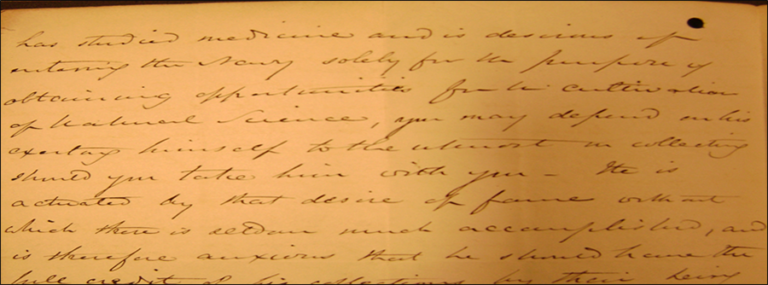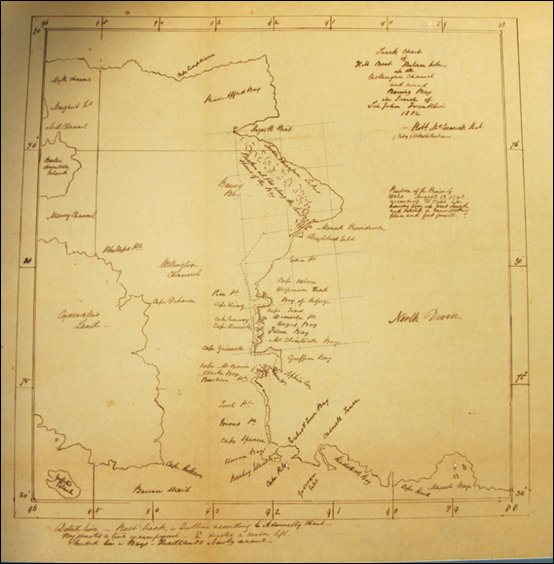So far (in my previous post), we have seen the influence of scientific reforms on the careers of naval servicemen in physical sciences such as astronomy and magnetism. However, in every surveying and discovery voyage there was a lesser-known branch of scientific servicemen: naval surgeons.
The position of naval surgeon, the so-called ‘surgeon naturalist’, is a traditional one, going back to the time when the ship’s doctor was the only member of the ship’s complement who had received any scientific training, and who was therefore the most suitable person to collect such things as natural history specimens.
Many naval surgeons had been trained at the medical school at Edinburgh, where the distinguished university and museum provided the best training in natural history available in Europe, and which were run by Professor of Natural History Robert Jameson. He supplied the Admiralty with surgeon naturalists and trained many famous naturalists of the 19th century, such as John Richardson and Charles Darwin.
Prior to the 1830s, civilian scientists were an important complement of many scientific voyages, as can be seen in Matthew Flinders’ voyage in 1801 when two draftsmen, an astronomer, a naturalist, and a landscaper and gardener, all of whom were civilians appointed by Banks, accompanied the voyage.
But after the Napoleonic wars, the necessity to carry civilians decreased. When Franklin embarked on his expedition to reach the Arctic Ocean overland down the Coppermine River, he took with him John Richardson, a naval surgeon who had recently obtained a medical degree from Edinburgh University. After a desperate journey and very nearly starving to death, they returned to a hero’s welcome; Richardson became a leading ichthyologist and an authority on Arctic fauna, and Franklin was elected as fellow of the Royal Society.
We could say that during the first half of 19th century going on such a voyage of a scientific nature was the best route to professional success in the biological sciences in Britain, as there was a certain chance of doing fieldwork. Travelling was one of the main ways in which people like Hooker, Huxley and Darwin could establish themselves as serious men of science, bearing in mind that during this period there were no science degrees on offer (they emerged much later in the century), nor were there any established scientific career paths.
In answering the question of how scientific reform could influence the careers of naval personnel, I will provide some examples by referring back to the Antarctic voyage of the Erebus and Terror in 1839-1843. The influence of scientific voyages such as these provided a career ladder for naval surgeon Joseph Dalton Hooker, later Sir Joseph Dalton Hooker, the Director of Kew Botanical Garden.

This famous voyage was the first scientific expedition to the Antarctic. The ships were the first to penetrate the Antarctic pack ice and to enter the ‘lagoon’, later named the Ross Sea, and to encounter the ‘Great Ice Barrier’, later renamed the Ross Ice Shelf.
On 30 September 1839, the Erebus accompanied by the Terror set sail and headed for the Antarctic. One member of the ship’s complement on board was Joseph Dalton Hooker. He was 22 years-old, the son of Sir William Hooker, Professor of Botany at Glasgow and the Director of Botanical Garden at Kew. The Young Hooker was persuaded by John Richardson, an eminent naturalist, to sail with Ross in the Erebus. Ross only agreed to take him if he qualified as a naval surgeon. After he gained the qualification, Hooker sailed as Assistant Surgeon and Botanist, not as Naturalist – a post which went to Robert McCormick, a senior surgeon who had more polar experience.
At the time of the Erebus and the Terror voyage, botany and biology did not qualify as sciences; science was supposed to be about mathematics and experimentation, accuracy and precision and, above all, it was supposed to be underlined by general laws. Hooker was aware that botany still lacked general laws and he hoped that the plant distribution, or plant geography, would provide the chance to discover such laws.
I have already pointed out early in this study that the characteristic of scientific enquiry in the first half of the 19th century was Humboldtian science, and plant geography was one such enquiry suggested by Humboldt’s paradigm.
The development of biological science, and especially of botany, can be traced back to the early 18th century and, by the middle of the century, botanists generally concentrated their efforts on finding plants and classifying the specimens into species and higher taxa according to the Linnean system of taxonomy, in which the results of field collecting were summed up in species lists or catalogues of all plants present in a given area. Hooker, however, was an enthusiastic devotee of Humboldtian plant geography and was more interested in the study of collective phenomena, in the hope that it could lead to understanding the nature of plant distribution and, ultimately, to the discovery of the laws which explained why particular plants grew where they did.
On the voyage to the Antarctic on board the Erebus, he was struck by the similarity of Hermite Island to the west coast of Scotland, and found the plants of the two regions to be closely analogous; this is the aspect of botany in which he was greatly interested – the diffusion of species over the surface of the globe.
After the voyage home of the Erebus and the Terror in 1843, Joseph Hooker lost no time in getting started on the botany of the voyage (Flora Antarctica, Botany of Fuegia, the Falklands, Kerguelen’s Land etc.). These superb volumes, which not only established Hooker’s botanical reputation as a taxonomist and phytogeographer so that he could earn a living as professional botanist, but also raised the prestige and status of botany itself, so that it could take its place alongside other prestigious physical sciences.

On the same voyage, the position of Zoologist (i.e. senior naturalist) was occupied by Senior Surgeon Robert McCormick, who was an Arctic veteran.
McCormick’s case is an interesting one. He was a Senior Surgeon on active service, and had held the rank for over 30 years; he had served in three Polar Expeditions, and spent many wintering; he had joined Sir William Edward Parry in his attempt to reach the North Pole in 1827, and commanded a boat expedition in search of Sir John Franklin in 1852.

However, he found it difficult to make his mark. His final and the highest post he held was Deputy Inspector-General, 13 men of the same rank having been promoted over his head. Comparing him to Joseph Dalton Hooker sheds light on how science influenced the career of Royal Navy scientific servicemen during the first half of the 19th century.
McCormick spent his childhood near Great Yarmouth. His father, also a naval surgeon, wanted him to become a naval executive officer, but the death of his father following the wreck of the Defense in December 1817 left him without the necessary influence and means. In 1821, Robert decided to enter the Royal Navy as a surgeon. He came to London, was accepted as an apprentice, and was a star pupil of the leading surgeon of the period, Sir Astley Paston Cooper.
McCormick joined the Navy in 1823 as Assistant Surgeon and was assigned to the flagship Queen Charlotte for service in the West Indies. However, he was invalided home in 1825 because of a yellow fever epidemic at that station, and developed a keen dislike for the tropics. In his next appointment, which was most likely thanks to the influence of Sir Astley Paston Cooper, McCormick was able to join Parry’s Arctic voyage in 1826 as Assistant Surgeon aboard the Hecla in an attempt to reach the North Pole by Spitsbergen, but he was not a member of Parry’s unsuccessful polar sledge party. He contributed significantly to the expedition by keeping the crew healthy and by studying the plants, animals and geology of Spitsbergen.
After the expedition returned he was promoted to the rank of Surgeon on 27 November 1827. After a year on half-pay, McCormick was assigned to the Hyacinth in the same West Indies station. However, he was again surveyed and invalided home on 1 May 1830.
By the time of his return from the Arctic voyage he had firmly decided upon a scientific career. McCormick prepared himself by attending a full term of lectures on Natural Philosophy at Edinburgh University under distinguished Professor Robert Jameson.
In May 1831, his application to join a scientific voyage of discovery was refused, but he was posted on board the Beagle on the voyage which made Charles Darwin famous in 1832.
McCormick left the Beagle at Rio de Janeiro on 24 April 1832. The circumstances surrounding McCormick’s departure from the Beagle were explained by Darwin’s letter to his sister Caroline on 25 April: ‘McCormick being disagreeable to the Captain’. But the most probable cause of this was a ‘conflict of role’[ref]Darwin Correspondence Project, ‘Letter no. 166,’ accessed on 24 February 2021.[/ref].
Darwin’s position on board the Beagle was that of private passenger and companion to Robert Fitzroy, the ship’s captain. The private character of Darwin’s position meant that he had overall control of his natural history collections, and could leave whenever he liked.
McCormick reflected on this incident when he was in his 80s: ‘Having found myself in a false position on board a small and very uncomfortable vessel, and very much disappointed in my expectations of carrying out my natural history pursuits, every obstacle having been placed in the way of my getting on shore and making collections.’ It was this special position which Darwin occupied which led to McCormick finding himself in ‘a false position’; however, it was not this alone that influenced the career path of McCormick – his frustration reflected the changing nature of science at the time.
Although McCormick was only nine years older than Darwin, the two men represented two quite different traditions in natural history. McCormick emerges from his own words and from the occasional references to him by both Darwin and Hooker as a typical collector, whose intellectual sources were the cabinet constructors of the 18th century who sought the specimens of the exotica of nature in order to provide substance for the system of order prescribed by Linnaeus. Valuable as this approach and as this activity were for the furtherance of natural science, it had become traditionalized and ritualized already by the end of the first quarter of the 19th century.
The emphasis shifted from collecting for collecting’s sake to the analysis of specimens and data collected, which made the traditional way obsolete. This drove a younger generation to an intense, full-time devotion to the study of nature as a whole, which was the beginning of professionalism in natural science.
In the words of Darwin, commenting on McCormick’s return to England, ‘he [McCormick] was a philosopher of rather ancient date…’. Hooker depicted McCormick as a pleasant man devoted to the pursuit of natural history; but he was too much of an amateur to develop the almost single-minded commitment, so characteristic of Charles Darwin or Joseph Hooker, which would make him a natural scientist. It was this difference which separated the turn-of-the-century naturalists from those of a subsequent generation and which frustrated Robert McCormick.